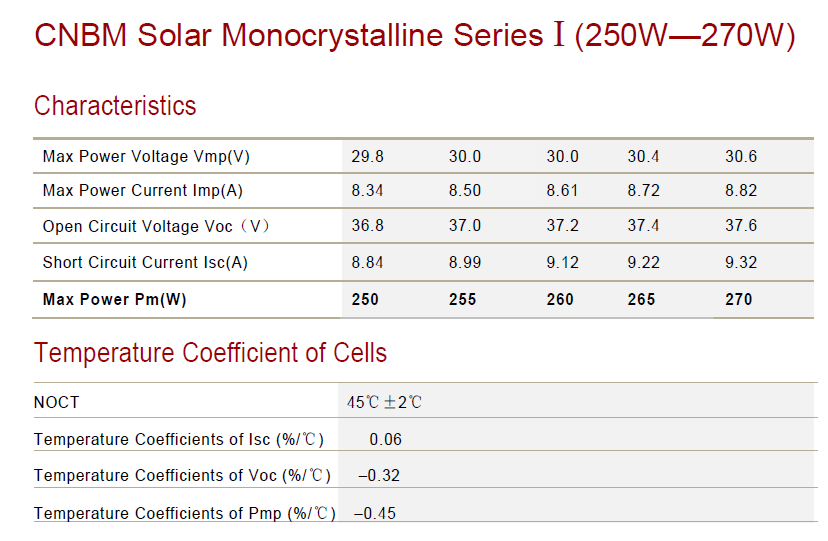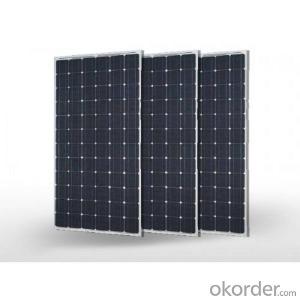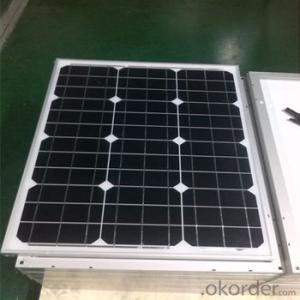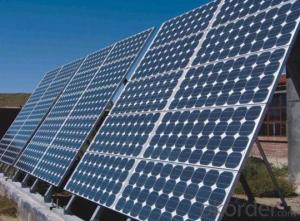SOLAR PANEL MONO260wSOLAR PANEL PRICE IN CHINA
- Loading Port:
- Shanghai
- Payment Terms:
- TT OR LC
- Min Order Qty:
- 2600 watt
- Supply Capability:
- 26000 watt/month
OKorder Service Pledge
OKorder Financial Service
You Might Also Like
Item specifice

| Rated maximum power (Pmax) | 200W |
| Open circuit voltage (vOC) | 45.43 |
| Short circuit current (Isc) | 5.56 |
| Maximum power voltage (Vmp) | 37.94 |
| Maximum power current (Imp) | 5.24 |
| Cell efficiency (%) | 18.00% |
| Max system voltage (VDC) | 1000V DC |
| Temperature coefficient of Vm | -0.241%/K |
| Temperature coefficient of Im | 0.033%/K |
| Temperature coefficient of power | -0.37%/K |
Solar panel working process
In addition to being the ultimate source of all life on earth, the sun is an infinitely renewable, completely pollution-free source of electricity. Instead of burning fossil fuels dug up from the ground in a big power plant – a very 19th century, industrial age approach, when you think about it – solar panels convert sunlight directly into electricity, with no harmful emissions.
The basic unit of a solar panel is a solar cell, which usually consists of one or two layers of silicon-based semiconductor wafers. When struck by the photons in sunlight, the solar cell generates an electrical charge due to the "photovoltaic effect" – which is a pretty good name, since it produces voltage from photons. The flow of these electrons moves in a steady electrical current from one side of the cell to the other.
Dozens of these PV cells are packaged together into solar modules, which in turn are packaged into solar panels that are mounted on a rooftop and arranged to maximize their hours of exposure to direct sunlight. Because the electricity generated by all those solar cells is direct current (DC), it is then sent to an inverter that transforms the power into the same alternating current (AC) used by the appliances in your home and the local utility electricity distribution grid. Increasingly, these inverters are getting "smart," providing data monitoring for solar installation performance and other grid integration services.
FAQ
We have organized several common questions for our clients,may help you sincerely:
③Can you provide the peripheral products of the solar panels, such as the battery, controller, and inverter? If so, can you tell me how do they match each other?
Yes, we can, we have two companies for solar region, one is CNBM International, the other is CNBM engineering Co.
We can provide you not only the solar module but also the off grid solar system, we can also provide you service with on grid plant.
④What is your warranty system?
Our product performance guarantees for 25 years
• 12 years guarantee for workmanship
• Timeliness of delivery
• Quality Products certified (TÜV, UL, CE, ISO)
- Q:Can solar panels be installed on a boat or yacht?
- Yes, solar panels can be installed on a boat or yacht. In fact, many boat owners choose to install solar panels to harness the power of the sun and generate electricity while out on the water. These panels are typically mounted on the deck or on top of a bimini, and they are used to charge batteries and power various onboard systems, reducing the reliance on traditional fuel sources.
- Q:what is the average cost, for a single family home, to install solar panels? I live in CA.
- Depends on the size of your home, how many appliances you want to run at one time, and how much sunlight you get because all of that determines how many panels you need and how many batteries you need to install. I checked into it earlier this year and it was going to take almost 25 years to pay for itself. They aren't cheap.
- Q:Can solar panels be used for charging laptops or smartphones?
- Yes, solar panels can be used for charging laptops or smartphones. Portable solar panels, such as those designed for outdoor activities or camping, are available in the market. These panels can convert sunlight into electricity and charge your devices through USB ports or power banks. Additionally, some laptops or smartphones also have the capability to directly charge from solar panels using special adapters or cables.
- Q:I read on CNN's website last year some company was creating a very cheap type of solar panel, that needs minimal maintenance and and has minimal glare from the sun. And the creator of the project said he one day wanted to cover every rooftop in the US with these solar panels. Seems like a good idea to me but I havent heared anything of it for a long time and I don't know what they are called... any help?
- Solar panels are one of the hottest areas in materials research today - from basic science to applied production techniques. There have been major strides in thin-film manufacturing technique as well as silicon technology. There's not a lot of hype about it because solar panel manufacturers don''t really need to advertise yet - they are selling at factory capacity with demand for more. Standard silicon solar panels now sell for around $3 a watt, and grid parity is expected within 5 years. Reference is to the MIT Technology Newsletter, which runs several articles a month on new solar tech.
- Q:Can solar panels be used in apartments or condominiums?
- Yes, solar panels can be used in apartments or condominiums. However, the installation process may vary depending on the specific building structure and ownership arrangements. In some cases, individual units can have their own solar panels installed, while in others, a shared or community solar system may be implemented to provide renewable energy to the entire building.
- Q:If a solar panel is a .5kW system, what length of time is it putting out that much power? Every hour?
- Solar panels are rated under standard test conditions (STC), a certain amount of light at a certain distance, at a certain temperature, etc. A kW, or kilo watt, is 000 watts. So for the amount of time that the sun meets those conditions, the rate of output is 500 watts. An average location has an average of 5 sun hours a day, the total time that you produce the rated output. Watts is a rate, like miles per hour (mph), how fast it is going. Watt hours, or kilo watt hours (kwh) is a quantity, like miles. So if you drive 50 mph for 5 hours, you went 250 miles (50 mph x 5 hours). If you produce .5kw for 5 hours, you have the potential to produce 7.5kwh a day. Multiply that by 30 days in a month, you get 225kwh a month. In reality you will lose about 30% of the rated power from less than ideal weather, system losses, etc., so it's more like 50kwh a month. You can look at your electric bill to see how many kwh you use a month, maybe around 000kwh, and see what percentage of your usage a system like that can power.
- Q:it is just for a simple project, but i am looking for a cheap, low cost, around one to two volts solar panel regulator uld y'all please help?
- Solar cells shouldn't need a voltage regulator for simple projects like driving motors or powering CMOS electronic circuits. I would need to know a little more on your goals for the project to help. However, I will put a few links that may be helpful to solar cells and some voltage regulators. The first link is general solar cell info and includes manufacturer lists at the end. The second is a link to educational solar cell kits and cells that may be useful for you. The last one is Digi-Key which is good for finding components to make your own voltage regulator. Hope this helps with your project!!
- Q:What is the impact of snow accumulation on solar panels' performance?
- Snow accumulation on solar panels can significantly reduce their performance. The layer of snow acts as a barrier, preventing sunlight from reaching the panels and reducing their ability to generate electricity. Additionally, the weight of the snow can cause structural damage to the panels if not properly cleared, potentially leading to long-term issues. Therefore, it is important to remove snow from solar panels to ensure optimal performance and longevity.
- Q:Can I add reflectors or mirrors around the solar panels to increase the power they generate?
- You could (an example of concentrating sunlight is called cloud gain, where the edge of a cloud will intensify sunlight as it passes between the sun and your panels), but that will make your panels run hotter and will probably reduce their life. It's better from a system design standpoint to simply get another panel or two. DK
- Q:Can solar panels power an electric car?
- Yes, solar panels can power an electric car. Solar panels convert sunlight into electricity, which can then be used to charge the batteries of an electric car. This allows the car to run on clean, renewable energy and reduces reliance on fossil fuels.
1. Manufacturer Overview |
|
|---|---|
| Location | |
| Year Established | |
| Annual Output Value | |
| Main Markets | |
| Company Certifications | |
2. Manufacturer Certificates |
|
|---|---|
| a) Certification Name | |
| Range | |
| Reference | |
| Validity Period | |
3. Manufacturer Capability |
|
|---|---|
| a)Trade Capacity | |
| Nearest Port | |
| Export Percentage | |
| No.of Employees in Trade Department | |
| Language Spoken: | |
| b)Factory Information | |
| Factory Size: | |
| No. of Production Lines | |
| Contract Manufacturing | |
| Product Price Range | |
Send your message to us
SOLAR PANEL MONO260wSOLAR PANEL PRICE IN CHINA
- Loading Port:
- Shanghai
- Payment Terms:
- TT OR LC
- Min Order Qty:
- 2600 watt
- Supply Capability:
- 26000 watt/month
OKorder Service Pledge
OKorder Financial Service
Similar products
New products
Hot products
Hot Searches
Related keywords




























